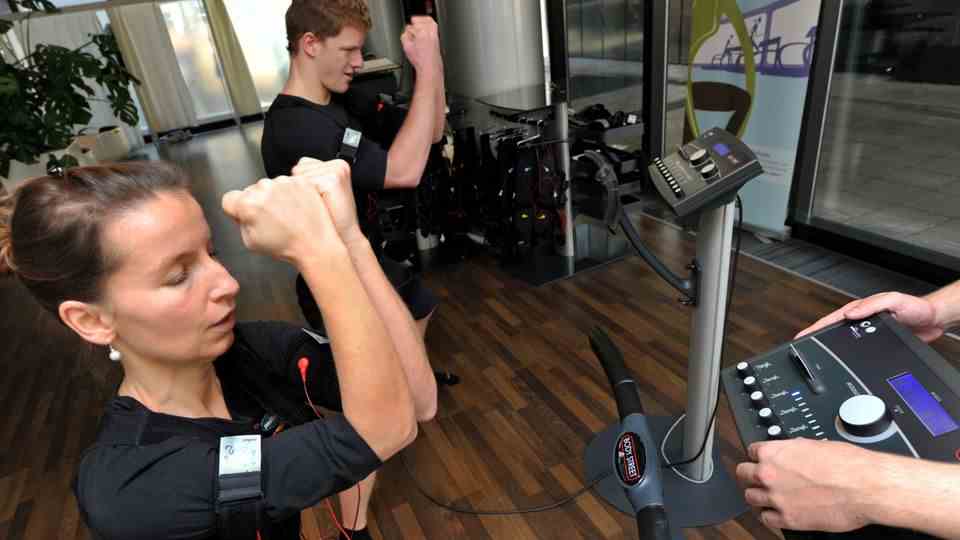fitness trend
EMS training – how it works and who really benefits from it
There should be at least 3000 EMS studios in Germany by now. And there seems to be a demand for the 20-minute low-frequency power workout. But what is the real benefit of EMS training?
© stockfour / Getty Images
EMS actually sounds too good to be true. Just 20 minutes of electro-myo-stimulation per week – then you can get those six pack abs too. Is this right? Of the star clarifies and explains who really benefits from EMS training and who should better keep their hands off it.
In big cities, they have been sprouting up like mushrooms for years. Well-trained athletes adorn their shop windows – cheeky claims and screens with videos are intended to attract customers. EMS Studios. Many do not even know what EMS stands for. They really can’t do anything with EMS training.
What does the abbreviation EMS actually stand for?
EMS is the abbreviation for electro-myo-stimulation, whereby “myo” – derived from the ancient Greek “mys” – means nothing more than muscle. And the name suggests it: EMS involves targeting and stimulating the muscles or individual muscle fibers from the outside using electrical impulses. The goal: to achieve more intense muscle tension than is possible through voluntary control. A basically simple and recognized principle that has been used by physiotherapists in rehabilitation, among other things, since the 1970s. For example, to treat muscular injuries such as strains or a torn fiber, to rebuild weakened muscles after operations or to improve their control and, in the best case, to shorten the healing process. A few years ago, the somewhat cumbersome and outdated term stimulation current therapy became the much more catchy abbreviation EMS. And this is how EMS training developed.
EMS has long since ceased to be used solely for therapeutic purposes: EMS training is now successfully involved in the highly competitive fitness market. In 2018 there were said to be around 2,500 so-called micro-studios in Germany alone, in which EMS training was offered. In addition to leisure and popular sports, EMS is also increasingly finding supporters in competitive and high-performance sports. It is a recognized training method in triathlon, for example, but also in badminton, cycling and swimming.
How does EMS training work?
The following scenario: You are in the gym and want to train your biceps. Holding a dumbbell, keep your arm stretched out and relaxed next to your body. The plan: you want to bend your elbow to bring the barbell up while tensing your upper arm muscle. Before this movement occurs, the synapses at the ends of nerve cells in the brain send electrochemical signals throughout the body to individual muscle cells. The arm is bent, the biceps tightened. During EMS training, small electrodes now take over or support the work of the synapses. This is possible because the muscle fibers don’t care whether the commands to be carried out come from the brain or from a machine. As a rule, these are incorporated into special vests or integrated into pods that are glued to the athlete’s skin before the training session. The electrodes now send additional electrical impulses – low-frequency current surges with a voltage of around nine volts and between 50 and 90 milliamps – to the underlying muscles, which contract accordingly. Depending on the exercise and the setting of the device, an impulse during EMS training lasts between one and five seconds. Ultimately, it strengthens what you otherwise sweat for on the weight bench or on the leg press – muscle building.
EMS training = six pack from the socket?
Is it enough to go to an EMS studio once or twice a week with a wet electron vest? Of course, the EMS training, which usually lasts 20-25 minutes, is not quite as comfortable and stress-free as it first sounds. Because the mere stimulation of the muscles by means of current impulses, the so-called isometric or static EMS training, activates the muscles but, according to experts, only allows them to grow to a limited extent. Noticeably more – and numerous studies (among others by scientists from the German Sport University Cologne and the University of Erlangen) have proven this – brings EMS training if the muscle fibers are additionally controlled voluntarily. This means that the athlete tenses the muscle group to be trained of their own accord – parallel to this, the current impulse comes from the machine and intensifies the exercise. The combination of the two components is also called dynamic EMS training.
Important: All variants of EMS training should be carried out under the supervision and guidance of a qualified and well-trained trainer.
How effective or efficient is EMS training?
For many years there was a confusing report from the German Sport University Cologne claiming that EMS training was 18 times more efficient than conventional fitness training. A number that quickly became independent. The data was based on a study by the Cologne scientist Dr. Heinz Kleinöder on the concentration of creatine kinase (CK). CK is an enzyme that is released during intensive strength and muscle training and is used by sports scientists as an indicator for training control. This value expressly does not serve as an indication of greater efficiency. A CK value that is too high poses health risks, especially for people who are not very well trained or who are completely untrained. But more on that later.

© Frank Leonhardt / Picture Alliance
professor dr Wolfgang Kemmler (Friedrich-Alexander University of Erlangen-Nuremberg) took on the parameters of muscle mass, muscle strength and body fat in order to check EMS training for its efficiency compared to conventional strength training. In comparison with the so-called high-intensity training (HIT), a progressive and also less time-consuming strength training, his team could not find any significant differences. Because the most important parameters, including blood and abdominal fat levels, developed significantly positively, the sports physician came to the conclusion that both HIT and EMS training are not only time-saving, but also suitable for improving the performance of untrained men in the middle increase age.
Positive effects through EMS training
Also the already mentioned Dr. In various research projects, Kleinöder has dealt with the physiological effects of full-body EMS training. The sports scientist found, among other things, that EMS training in people with chronic cardiac insufficiency strengthens the muscles controlled by the electrical impulse, improves oxygen uptake and has a positive effect on diastolic blood pressure, the lower blood pressure value. Significant increases in strength were recorded by Dr. Kleinöder also for active athletes from different sports. The isometric maximum strength in this group improved by an average of almost 33 percent after EMS training. In the case of untrained people, it was still 23.5 percent.
How many calories do you burn with EMS training?
There are also studies on this. According to this, 19 young men burned an average of just over 400 kcal during a 16-minute EMS training session. Projected onto a 20-minute dynamic EMS training session, that would add up to 515 kcal. For comparison: during a 20-minute run at a moderate pace, the body burns around 200 kcal.
For whom EMS training is suitable – and for whom not?
Used consciously and correctly, EMS training offers the less and untrained as well as recreational and ambitious recreational athletes as well as top athletes the opportunity to improve their muscle strength holistically, specifically and in a way that is gentle on the joints within a short period of time. Even seniors can benefit. Because EMS training can – provided it is used in doses – slow down the muscle atrophy that occurs with age. However, stimulation current training is not an option for patients with chronic cardiac insufficiency or epilepsy. In the case of infections and implants, caution is required and support from a physiotherapist or trainer is advisable.
How much does high-quality EMS training cost?
Compared to memberships in conventional fitness studios, you have to dig a little deeper into your pocket for EMS training in a studio with a large EMS provider. The fitness chains charge between 20 and 30 euros per week for their EMS training. With long-term contracts, it is usually a little cheaper. As a rule, one to two EMS training days per week are agreed. The fee usually includes a one-off trial session (sometimes a trial month), an initial interview and personal support and guidance from a trainer. If you book EMS training in a physiotherapy practice or with a personal trainer, it can get a little more expensive.
You might also be interested in:
Sources:“cycling-news.com”; “German Sport University Cologne”; “ems-training.de”; “tens-ems-geraete.de”; “ndr.de”; EMS Symposium
This article contains so-called affiliate links. There is more information here.


